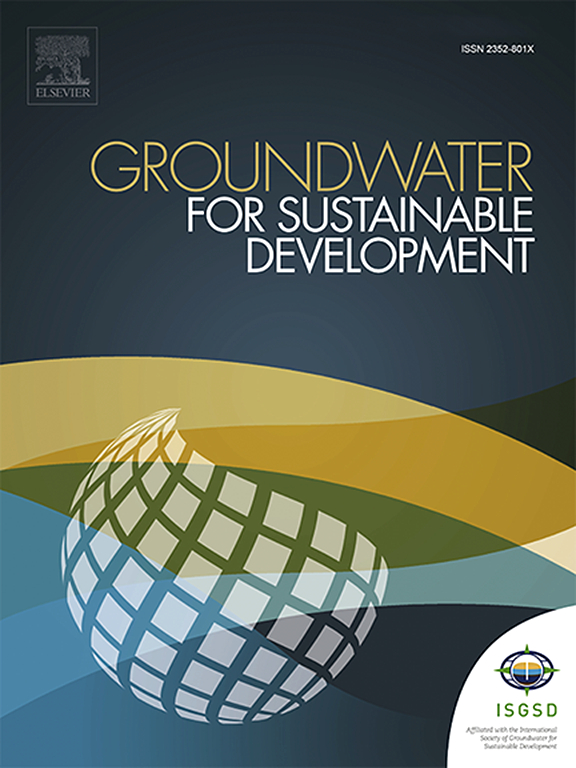巴基斯坦上印度河盆地的高海拔泉水勘探:政策发展的知识
IF 4.9
Q2 ENGINEERING, ENVIRONMENTAL
引用次数: 0
摘要
天然泉水是兴都库什、喀喇昆仑山和喜马拉雅(HKH)地区众多山区社区的重要清洁水源。由于城市化和气候变化的加剧,该地区对水的需求已经成倍增加,但人们对这一资源缺乏足够的认识和了解。本研究对巴基斯坦上印度河流域 HKH 地区不同地貌条件下的泉水前景进行了调查,以促进水资源的可持续管理。在该地区发现的 3864 个泉眼中,约 14.9% 的泉眼位于海拔 1500-2000 米范围内,14.8% 的泉眼位于海拔 1000-1500 米范围内,14% 的泉眼位于海拔 3500-4000 米范围内。高山(3000 米)上的泉眼最多,达到 1612 个,其次是低山(1200-2000 米)上的 927 个泉眼和中山(2000-3000 米)上的 842 个泉眼。喜马拉雅山脉的泉水密度最大(即 0.05 个/平方公里),其次是兴都库什山脉(即 0.04 个/平方公里)和喀喇昆仑山脉(即 0.01 个/平方公里)。总体而言,三个香港山脉的泉眼密度超过 0.03 个/平方公里。泉水与年降雨量呈正相关(R2 值为 0.79),突出表明降雨量对该地区泉水资源的影响。采用水资源综合管理方法和高效用水对维持该山区的泉水资源至关重要。在气候和土地利用不断变化的背景下,对泉水的水动力特征进行深入研究对于满足未来不断增长的用水需求和改善香港山脉地区社区的生计至关重要。本文章由计算机程序翻译,如有差异,请以英文原文为准。

Prospecting high-altitude springs in the Upper Indus Basin, Pakistan: Knowledge towards policy development
Natural springs form a significant source of clean water for a large number of mountain communities in the Hindu Kush, Karakoram and Himalaya (HKH) region. Adequate knowledge and understanding of this resource are lacking in this region where water demand has already been increased manifold owing to growing urbanization and climate change. In the present study, prospects of springs have been investigated under different physiographic conditions in the HKH region of Upper Indus Basin, Pakistan for sustainable water resource management. Among 3864 springs identified in the region, a maximum of about 14.9 % springs lie within 1500–2000 m elevation range followed by 14.8 % within 1000–1500 m and 14 % within 3500–4000 m range. A maximum of 1612 springs were observed over high mountains (>3000 m), followed by 927 springs over low mountains (1200–2000 m) and 842 over middle mountains (2000–3000 m). The spring density was observed maximum in the Himalaya (i.e., 0.05 springs/km2) followed by the Hindu Kush range (i.e., 0.04 springs/km2) and the Karakoram range (i.e., 0.01 springs/km2). Overall the density was found to be over 0.03 springs/km2 in the three HKH ranges. The spring indicated a positive relationship with annual rainfall (R2 value 0.79) highlighting the influence of rainfall in sustaining spring resource in the area. The adoption of an integrated water resource management approach and efficient water use are essential to sustain spring resource in this mountainous region. In-depth research on the hydrodynamic characteristics of springs is essential in the context of changing climate and land use to meet growing water demands and improve communities’ livelihoods in the HKH region in future.
求助全文
通过发布文献求助,成功后即可免费获取论文全文。
去求助
来源期刊

Groundwater for Sustainable Development
Social Sciences-Geography, Planning and Development
CiteScore
11.50
自引率
10.20%
发文量
152
期刊介绍:
Groundwater for Sustainable Development is directed to different stakeholders and professionals, including government and non-governmental organizations, international funding agencies, universities, public water institutions, public health and other public/private sector professionals, and other relevant institutions. It is aimed at professionals, academics and students in the fields of disciplines such as: groundwater and its connection to surface hydrology and environment, soil sciences, engineering, ecology, microbiology, atmospheric sciences, analytical chemistry, hydro-engineering, water technology, environmental ethics, economics, public health, policy, as well as social sciences, legal disciplines, or any other area connected with water issues. The objectives of this journal are to facilitate: • The improvement of effective and sustainable management of water resources across the globe. • The improvement of human access to groundwater resources in adequate quantity and good quality. • The meeting of the increasing demand for drinking and irrigation water needed for food security to contribute to a social and economically sound human development. • The creation of a global inter- and multidisciplinary platform and forum to improve our understanding of groundwater resources and to advocate their effective and sustainable management and protection against contamination. • Interdisciplinary information exchange and to stimulate scientific research in the fields of groundwater related sciences and social and health sciences required to achieve the United Nations Millennium Development Goals for sustainable development.
 求助内容:
求助内容: 应助结果提醒方式:
应助结果提醒方式:


